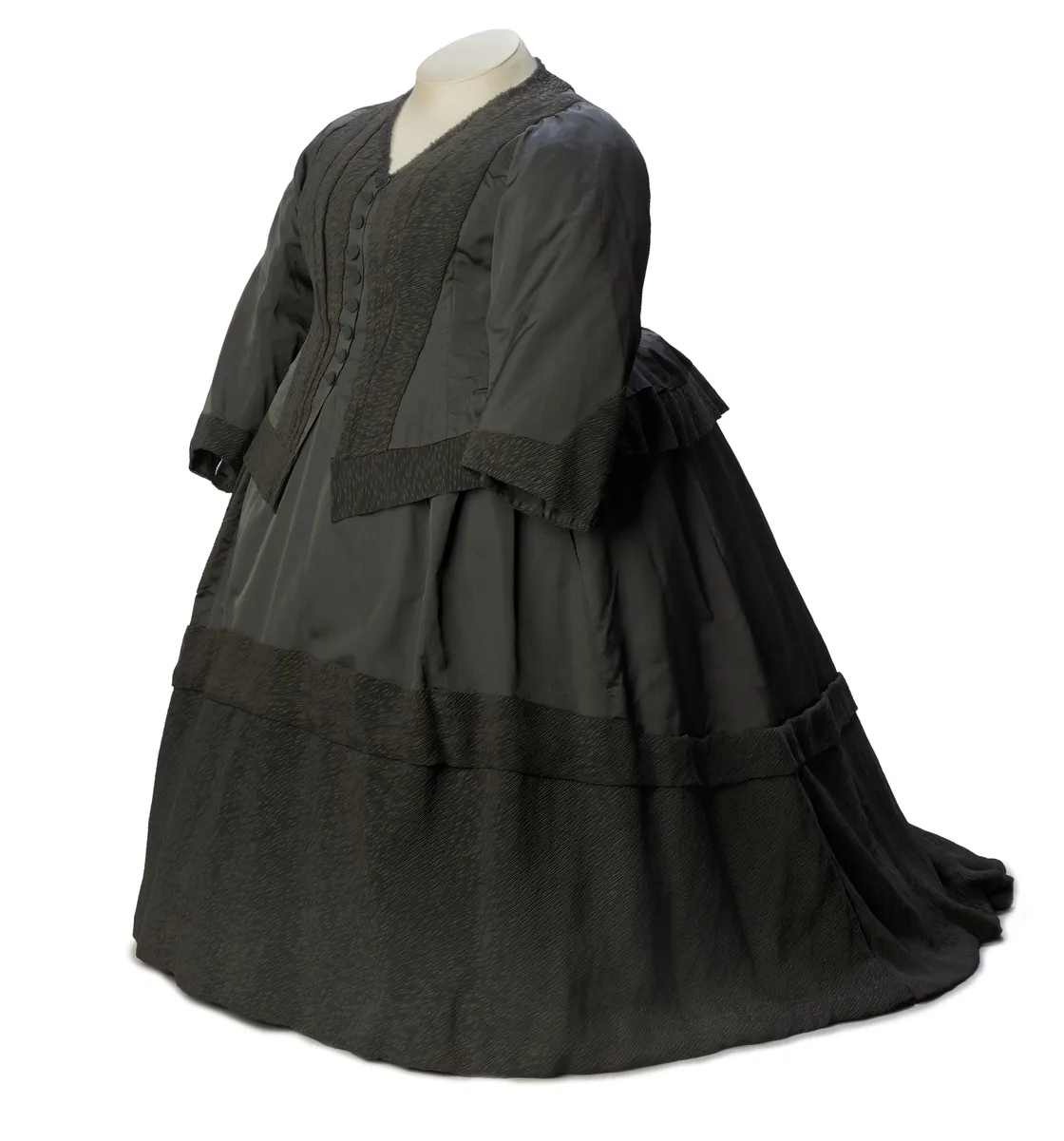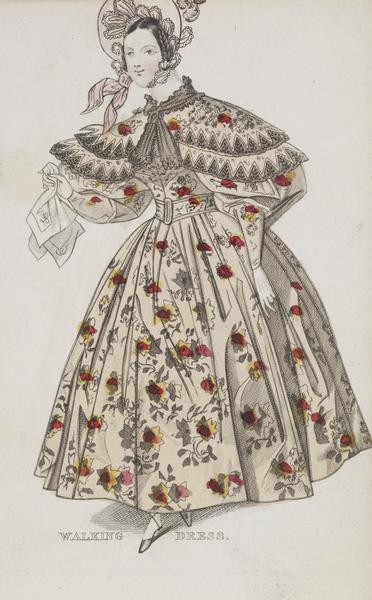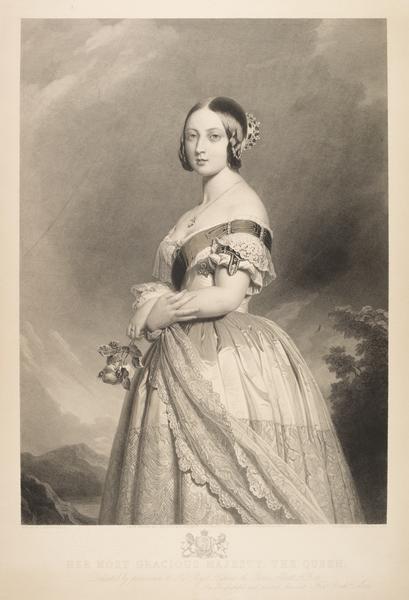13 August 2020 — By Emily Austin
Mounting Queen Victoria’s mourning dress
Queen Victoria wore this elegant black dress in mourning for her grandson who died in the 1892 influenza epidemic. But how do you display a fragile costume that’s over 100 years old?
London Museum has many fascinating and iconic objects relating to the British royal family in its collection. For a 2018–2019 display, I worked closely on a dress worn by Queen Victoria. The dress had not previously been on display at the museum, so this was a great opportunity to showcase one of our many objects with royal connections.
Queen Victoria in black and crepe
This dress has been dated to 1892. It is believed Victoria wore it in mourning following the death of her grandson Prince Albert Victor, Duke of Clarence, who died during an influenza pandemic. At this point in her life Victoria was in her early 70s, she was also in the fourth decade of mourning her husband Prince Albert, who had died in 1861.
Following Albert’s death, Victoria chose traditional black mourning wear for the rest of her life, a look that she is well known for. In her later years, Victoria’s height also appears to have decreased slightly from when she was younger, so when she wore this dress she would have stood at around 4 ft 8 in.
Comprising a bodice and skirt, the dress is made from black silk taffeta and embellished with layers of black silk mourning crepe. Mourning crepe is a textured open-weave silk, specifically worn to indicate to others that the wearer was in a certain stage of mourning. The bodice is lined in fine cream silk, with baleen (whalebone) boning at the waist.
Although most of the seams are machine stitched, the dress has many handstitched elements and shows a high quality of craftsmanship, as you may well expect the Empress of the British Empire at the height of its power to be wearing. These details – the quality and cut of the fabric, the colour, the shape, the size and texture – all help to build up a picture of the queen’s life at this time.
“This dress is in surprisingly good condition, considering its age and material”
Conserving Queen Victoria’s dress

This photograph shows the conserved dress, when mounted.
As a textile conservator, my job is to care for the museum’s large collection of fabric objects to maximise their longevity. This includes assessing, conserving and mounting objects required for exhibitions. This is always a collaborative process, working alongside other conservators, curators, exhibition designers and technicians.
This dress is in surprisingly good condition, considering its age combined with silk’s inherent tendency to degrade rapidly. This initially suggests that the dress was not worn very much. However, on closer inspection, the tell-tale signs of wear around the neckline indicate that it is likely to have been worn several times. The outside of the dress required minimal conservation treatment to prepare it for display, so my focus moved to the interior, which had several areas of damage. Although these will not be seen when on display, without appropriate support, these already fragile areas could be weakened during handling, especially with the accumulative strain of being mounted for several months.

The neckline after conservation.
The neckline showed the most amount of wear, with several splits and loose areas of braid. We used fine ‘hair’ silk to stitch a colour-matched silk crepeline (sheer woven fabric) overlay into place. I used a very fine curved surgical needle to slide easily through the delicate silk without damaging the weave.
The inner waist ties, which were used to keep the bodice cinched in at the waist, were in poor condition. Several long splits had formed where they had originally been tied and they were fraying along all the edges. As these grosgrain ribbons are densely woven, I selected an adhesive support rather than purely stitched support, to minimise the amount of stitching required. After preparing an adhesive-coated black silk crepeline support, I heat-set patches at a temperature of 70°C onto the splitting areas using a heated spatula and secured the edges with supplementary stitching.

Initial stage of padding with polyester wadding.
Mounting the mourning dress
After the dress was conserved the next stage was to mount it onto a mannequin. This was a challenge not only to create the correct period silhouette, but also in trying to represent such a recognisable historic figure as accurately as possible.
Unlike a dressmaker who begins with a figure and then creates a garment to fit, when mounting historic costume the shape of the figure is taken from the garment and the correct figure is built up like a sculpture. By measuring the bodice and skirt, and referring to contemporary photographs of Victoria, I was able to pad up a standard mannequin (UK size 16) to suitable proportions using layers of polyester wadding.
“When mounting historic costume…the correct figure is built up like a sculpture”
This was first pinned into place and then each layer secured with stitching. Some more drastic adjustments also needed to be made by cutting down the long slender neck and adding padding to widen it.
After the padding was in place, I made a fitted cotton jersey cover and then padded fabric covered arms using a similar method to the torso. The neck was covered in cream silk habotai, to tie in with the overall exhibition design, and the arm ends were covered in black silk.
Once the torso and arms were complete, I built layers of underpinnings to create the full skirt and bustle that were the fashionable shape of the 1880–1890s. Layers of gathered nylon net were built up onto a boned tube skirt, and a boned full length bustle was made to hold up the weight of the silk layers needed for the length of the exhibition. A soft gathered net layer and black silk overskirt were the final layers to provide a smooth surface to easily slide on the skirt.
Once dressed and the skirts carefully arranged, a final light vacuum was needed to remove any fibres or dust from the crisp black silk and then the dress was ready to be installed in the gallery. It took three people to lift the dressed mannequin safely into its display case, while supporting the mannequin and the long skirt train.
Emily Austin is Textiles Conservator at London Museum.
















